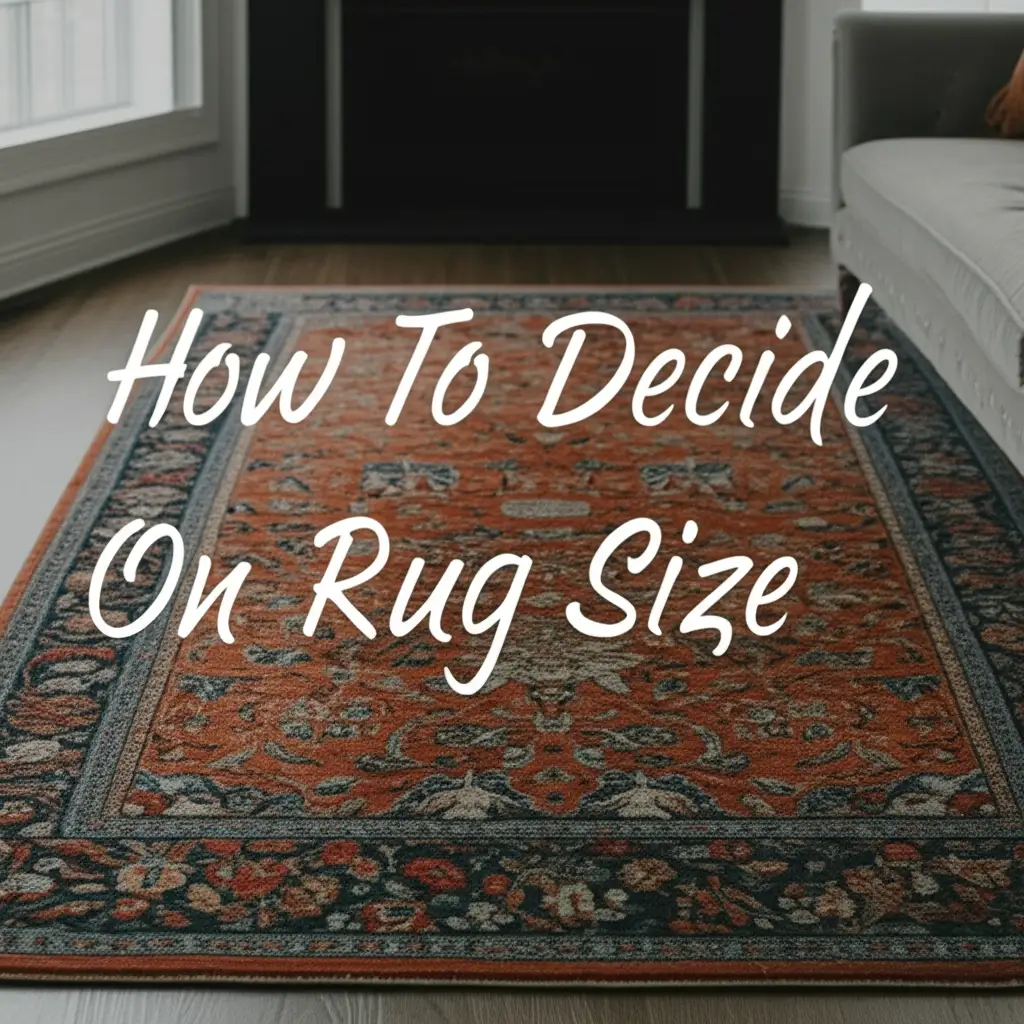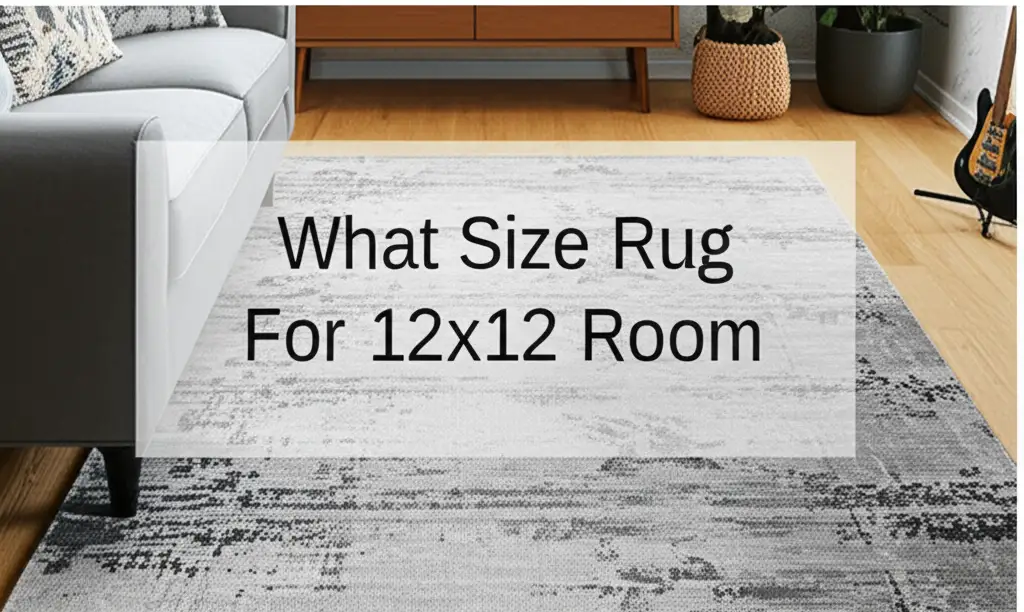· Liora Benning · Home Cleaning · 19 min read
How To Decide On Rug Size

How To Decide On Rug Size for a Perfect Home Look
Have you ever wondered why some rooms just feel right, while others seem a bit off? Often, the secret lies in the details. A major detail is the rug. It can truly make or break a space. Knowing how to decide on rug size is a skill that will transform your home.
Getting the rug size right makes a room look complete and inviting. A rug defines areas and ties furniture together. Too small, and your room can look disjointed. Too large, and it might overwhelm the space. This guide helps you pick the right rug size every time. We will cover measuring, common sizes, and room-specific tips. Let’s find your perfect rug fit.
Takeaway: Your Guide to Choosing the Right Rug Size
- Measure First: Always measure your room and main furniture items before shopping.
- Room Function Dictates: Different rooms have different rug rules for size and placement.
- Anchor Furniture: Ensure at least the front legs of major furniture pieces sit on the rug.
- Allow Border: Leave 18-24 inches of bare floor around the rug in most living areas.
- Consider Traffic: Choose rug sizes that cover main walking paths to protect floors and add comfort.
How to Decide on Rug Size? A Quick Answer
To decide on rug size, measure your room and main furniture pieces. Pick a rug that anchors at least the front legs of major furniture, leaving 18-24 inches of bare floor visible around it in living spaces. Bedrooms need rugs large enough for the bed and nightstands or to extend beyond the bed’s foot.
Why Rug Size Matters for Your Home Design
Getting the rug size right is more important than you think. A properly sized rug can change how your room feels. It defines different areas within an open plan home. A well-chosen rug also protects your floors. It adds warmth and comfort underfoot.
An incorrect rug size can make a room look awkward. A rug that is too small often makes furniture float. This creates a disconnected look. On the other hand, a rug that is too big can make the room feel cramped. It might cover too much of your beautiful flooring. This defeats the purpose of an area rug. We want a rug to complement the room, not dominate it in a bad way. It should create balance and harmony.
The rug helps to ground your furniture. It provides a visual anchor for your seating arrangement. It also helps with noise reduction. A good rug can absorb sound in a room. This makes the space feel quieter and calmer. Think about how you use the room. Consider the main activities that happen there. This helps you understand the functional needs for your rug size. Proper sizing enhances both the look and the feel of your home. It ensures your rug works hard for you.
Measuring Your Space to Decide on Rug Size
Measuring your room correctly is the first step. Do not guess the size. Get a tape measure and write down the dimensions. You need the length and width of the room. Also, measure your furniture pieces. This includes sofas, chairs, beds, and dining tables. These measurements help you visualize how a rug will fit.
Consider the layout of your furniture. Where will your sofa go? How far will chairs extend? A rug should anchor your main furniture items. This means at least the front two legs of your sofa and chairs should rest on the rug. This rule applies to most living areas. For bedrooms, the rug often goes under the entire bed. It should extend out from the sides and foot of the bed.
Leave some bare floor around the rug. A common rule is to leave 18 to 24 inches of floor visible on all sides. This creates a natural border. It prevents the rug from looking like wall-to-wall carpet. In smaller rooms, you might reduce this border. For larger rooms, you can increase it slightly. Having this border helps frame the rug. It shows off your floor. This step is key to knowing how to know rug size for your space. Mark the desired rug area with painter’s tape. This helps you see the actual footprint. This simple trick prevents sizing mistakes.
Common Rug Sizes and Their Uses
Different standard rug sizes fit different spaces and needs. Knowing these sizes helps you narrow down your choices. Let’s look at common dimensions and where they work best.
Standard Rug Sizes
- 2’x3’ or 3’x5’: These are small accent rugs. You can use them by a door as a doormat. They also work well in front of a sink in a kitchen or bathroom. They add a pop of color or texture. They are not meant to anchor furniture.
- 4’x6’ or 5’x7’: These sizes work for smaller rooms or specific zones. You can place a 4’x6’ rug under a coffee table with two chairs. A 5’x7’ might fit in a small bedroom under the foot of a twin bed. They are good for defining a reading nook.
- 6’x9’: This is a versatile size. It works well in smaller living rooms. It can anchor a small sofa and two chairs. Ensure the front legs of all seating are on the rug. It is a good choice for apartments or compact spaces.
- 8’x10’: This is a very popular size for average living rooms. It holds a standard-sized sofa, two chairs, and a coffee table. All front legs of seating should rest on this rug. It creates a cohesive seating area.
- 9’x12’: This size is perfect for larger living rooms or open-concept spaces. It can accommodate a larger sectional or multiple seating arrangements. Most furniture pieces, if not all, can sit entirely on this rug. This provides a grand look. If you are wondering what size rug for 9 x 12 room, a 9x12 rug can often be perfect, but it depends on your furniture layout.
- 10’x14’ or larger: These large rugs are for very spacious rooms. They work in great rooms or formal living areas. They define large zones. All furniture typically sits entirely on these rugs. These rugs create a truly grand statement.
Understanding these common rug dimensions helps you visualize their place in your home. This knowledge simplifies the rug selection process significantly.
Rug Size for Living Rooms: Creating a Cohesive Space
Choosing the right rug size for your living room is key to its design. The living room is often the heart of the home. Your rug should define the main seating area. It needs to bring all your furniture together. There are a few common layouts to consider.
All Furniture on the Rug
This layout works best for large living rooms. The rug is big enough for all major furniture pieces to sit completely on it. This includes the sofa, armchairs, and coffee table. This creates a very grand and connected feel. It defines the space clearly. It also helps to minimize noise. This approach works well in open-concept homes. It clearly marks the living zone. This style demands a large rug, like a 9’x12’ or even 10’x14’.
Front Legs on the Rug
This is the most common and versatile layout. The rug is large enough for the front two legs of your sofa and any chairs to rest on it. The back legs remain on the bare floor. The coffee table also sits entirely on the rug. This option works for most average-sized living rooms. It connects the furniture visually. It also ensures comfort for your feet when sitting. An 8’x10’ rug often fits this style well. A 6’x9’ can work for smaller living rooms. This approach saves some money compared to a full coverage rug.
Floating Furniture
This option is for very small spaces or accent rugs. Here, only the coffee table sits on the rug. The sofa and chairs are off the rug. This layout can make a room feel disconnected. It often makes furniture appear to “float.” We do not recommend this for main seating areas. It is better for an accent rug in front of a fireplace or a specific small reading chair. A 5’x7’ or 4’x6’ rug might be used this way.
Remember to leave 18-24 inches of bare floor around the rug’s perimeter. This helps frame the seating area. It prevents the rug from looking like wall-to-wall carpet. Always measure your living room and furniture before buying. This ensures you pick the best rug size. For specific room dimensions, like what size area rug for 10x11 form room, a 6’x9’ or 8’x10’ might be suitable depending on furniture arrangement.
Rug Size for Dining Rooms: Defining Your Eating Area
Choosing the right rug size for your dining room is crucial. The rug needs to be large enough to accommodate the dining table and chairs. All chair legs should remain on the rug, even when pulled out. This prevents chairs from catching on the rug’s edge. It ensures smooth movement. It also protects your flooring from chair scuffs.
Standard Dining Room Rug Sizes
- For a 4-person table: A 6’x9’ or 8’x10’ rug usually works well. The rug needs to extend at least 24 inches beyond the table on all sides. This allows chairs to slide back comfortably.
- For a 6-person table: An 8’x10’ or 9’x12’ rug is often needed. Consider the shape of your table. A rectangular table often needs a rectangular rug. A round table might pair well with a round or square rug. For a 6-seated dining table, what size rug is often an 8x10 or 9x12, depending on the table and chair size.
- For an 8+ person table: A 9’x12’ or larger rug is necessary. You may even need a 10’x14’ or custom size. Large tables need large rugs to ensure chair movement. Always measure your table and chairs. Measure the space when chairs are pulled out. Add at least 24 inches to this measurement on all sides. This will give you the minimum rug size needed.
Round dining tables also need specific rug sizes. A round rug can be a good choice. Make sure its diameter is large enough. It should extend beyond the chairs when pulled out. This ensures full coverage. The same 24-inch rule applies here. For outdoor dining, especially a 6-person table, what size outdoor rug would follow similar guidelines. It ensures comfort and stability.
A rug in the dining room also helps absorb sound. This makes dinner conversations more pleasant. It defines the dining area in an open floor plan. It also adds warmth and style to your meals. Always prioritize function here.
Rug Size for Bedrooms: Adding Comfort and Style
A rug in the bedroom adds warmth, comfort, and a finished look. It also makes getting out of bed much nicer. The ideal rug size depends on your bed size and room layout. The goal is to have the rug extend beyond the bed. This creates a soft landing for your feet.
Bedroom Rug Placement Options
- Under the entire bed and nightstands: This is the most luxurious option. The rug is large enough to sit under the bed, nightstands, and often extends a good distance past the foot of the bed. This provides a plush surface for stepping out of bed. It also grounds the entire bed area. A 9’x12’ rug usually works well for a queen or king bed with this setup. For a 12x12 room, what size rug can be a 9x12 for a queen bed, or an 8x10 for a full bed. For an 11x11 room, what size rug can be an 8x10 for a queen bed.
- Under the bed, stopping before nightstands: This is a common and practical choice. The rug starts just under the nightstands. It then extends past the foot of the bed. This option saves on rug cost. It still provides ample soft surface around the bed. An 8’x10’ rug is often good for a queen bed here. A 6’x9’ might work for a full bed.
- Two-thirds under the bed: The rug is placed with about two-thirds of its length under the bed. The remaining one-third extends from the foot of the bed. This is a good option for smaller bedrooms. It still gives soft footing where you need it most.
- Runners on each side of the bed: If a large rug is not possible, consider two long runners. Place one on each side of the bed. They provide a soft spot for your feet. This works well for narrow rooms.
- One large rug near the foot of the bed: A single smaller rug can be placed at the foot of the bed. It can go under a bench or just in front of it. This adds visual interest and defines a small zone. It does not provide full coverage.
Aim for at least 18-24 inches of rug extending beyond the sides and foot of your bed. This ensures comfort. It also makes the rug look intentional. Consider your room’s size and bed dimensions. A rug instantly adds warmth and coziness to any bedroom.
Rug Size for Hallways and Entryways: Guiding and Protecting
Hallways and entryways benefit greatly from rugs. They protect your floors from heavy foot traffic. They also add a sense of welcome and define pathways. Runners are the best choice for hallways. For entryways, smaller area rugs or specific shapes work well.
Hallway Runners
Hallway runners come in various lengths. You need to measure your hallway length. Choose a runner that leaves about 4-6 inches of bare floor at each end. This ensures the runner does not look crammed. It also allows doors to open freely. Common runner widths are 2 feet or 3 feet. The width should not take up the entire hallway. It should leave some floor on either side. This makes the hallway feel wider. A runner should guide the eye down the hallway. It should not be a tripping hazard. Ensure it has a non-slip pad underneath. This is important for safety.
Entryway Rugs
For the entryway, the rug should fit the space. It should not block the door from opening. Measure the swing of your door before buying. A 2’x3’ or 3’x5’ rug is common for single entry doors. A round rug can also work if it fits the space. It adds visual interest. For double doors or larger entryways, you might use a 4’x6’ or even a 5’x7’ rug. The rug should define the entry point. It should capture dirt and debris. Choose durable materials for entryways. This area sees a lot of wear. An entryway rug welcomes guests. It protects your floors from outside elements.
Always consider the scale of the space. A too-small rug in a grand entryway will look lost. A too-large runner in a narrow hallway will feel overwhelming. The rug should enhance the space, not fight with it.
Common Mistakes to Avoid When Deciding on Rug Size
Choosing a rug can be exciting. But many people make similar mistakes. Knowing these pitfalls helps you avoid them. You will choose the right rug size the first time.
Choosing a Rug That is Too Small
This is the most common mistake. A rug that is too small makes furniture look disconnected. It creates a “floating” island effect. Your seating area will not feel cohesive. Imagine a small rug just under your coffee table. The sofa and chairs are completely off the rug. This setup looks incomplete. The room feels less inviting. Always aim for a rug that anchors at least the front legs of your main furniture. This is true for living rooms and bedrooms.
Not Measuring the Space
Many people guess rug sizes. This often leads to buying a rug that does not fit. Always measure your room. Measure the furniture you plan to put on or around the rug. Use painter’s tape to mark out the intended rug area. This visual aid is incredibly helpful. It shows you exactly how much space the rug will take up. It helps you see the empty floor space around it.
Ignoring Furniture Placement
The rug should work with your furniture. It should not fight against it. Think about the flow of traffic in the room. Ensure the rug does not become a tripping hazard. For dining rooms, ensure chairs can slide out fully while staying on the rug. In bedrooms, the rug should extend far enough from the bed. This provides soft landing spots for your feet. The rug helps define the furniture grouping.
Forgetting About Bare Floor Space
Do not choose a rug that goes wall-to-wall. This takes away from the purpose of an area rug. Area rugs define zones. They add texture and color. They are not meant to cover the whole floor like carpeting. Leave 18 to 24 inches of bare floor around the rug’s edges. In smaller rooms, 12 inches might be okay. This border frames the rug and shows off your flooring.
Not Considering Room Shape
A rectangular rug often works in a rectangular room. A round rug can add softness to a square room. Consider the room’s shape and how the rug will complement it. Do not force a square peg into a round hole, so to speak. Matching the rug shape to the room or main furniture piece (like a dining table) creates harmony. Avoiding these common mistakes will save you time and money. It ensures you select a rug that enhances your home.
Final Considerations When Deciding on Rug Size
Beyond basic measurements, a few more points help you decide on the perfect rug size. These details can make your space truly shine.
Room Scale and Proportion
Think about the overall size of your room. A tiny rug in a vast room will look lost. A huge rug in a small room can overwhelm it. The rug size should be in proportion to the room. It should also be proportional to the furniture it is anchoring. The rug should feel balanced within the space. It should not look like an afterthought. It should not be the only thing you see. This balance creates a pleasing visual.
Traffic Patterns
Consider how people move through your room. The rug should define pathways, not block them. In high-traffic areas, the rug should be large enough to cover the main walking path. This protects your floors from wear. It also adds comfort. Ensure the rug does not curl up at the edges. This can be a tripping hazard. A non-slip rug pad helps keep the rug flat and safe.
Open Concept Spaces
In open-concept homes, rugs are essential for defining zones. Use a large rug to define your living room area. Use another for the dining space. Ensure there is clear separation between the rugs. There should be bare floor in between. This helps differentiate the functions of each area. It prevents the space from looking like one giant, undefined room. Each rug should serve a specific purpose. Each should define a clear activity zone.
Visual Impact
A rug is a significant design element. Its size affects the visual impact of your room. A larger rug generally makes a room feel bigger and more luxurious. It creates a sense of spaciousness. A smaller rug can make a room feel cozier or define a small, intimate nook. Think about the overall feeling you want to create. Do you want expansive and open? Or cozy and contained? The rug size choice contributes to this feeling.
By considering these final points, you can make a more informed decision. You will choose a rug that not only fits your space but also enhances its beauty and function.
Frequently Asked Questions About Rug Size
What size rug should I get for a small living room?
For a small living room, a 6’x9’ rug often works well. Ensure the front legs of your sofa and any chairs rest on the rug. This connects the furniture visually. Leave about 12-18 inches of bare floor around the rug edges. This keeps the room from feeling too full.
How much bare floor should show around an area rug?
Generally, leave 18 to 24 inches of bare floor around an area rug in living and dining rooms. For smaller rooms, you can reduce this to 12-18 inches. This border helps frame the rug. It shows off your flooring, making the rug look intentional and not like wall-to-wall carpet.
Can a rug be too big for a room?
Yes, a rug can be too big. If a rug covers almost the entire floor, it loses its purpose as an “area” rug. It can make the room feel smaller and cramped. It might also look like wall-to-wall carpeting. The rug should define a zone, not cover the whole room.
Should all furniture sit on the rug?
It depends on the rug size and room. In large rooms, all furniture can sit entirely on a big rug. For most average living rooms, only the front legs of the sofa and chairs need to be on the rug. This helps anchor the furniture and create a cohesive seating area.
How do I choose a rug for a king-size bed?
For a king-size bed, a 9’x12’ rug is ideal. It allows the bed and nightstands to sit on the rug. It also extends out enough at the foot and sides for soft landing. Alternatively, an 8’x10’ can work if placed about two-thirds under the bed.
What is the most common rug size?
The 8’x10’ rug is one of the most common and versatile sizes. It fits well in many average-sized living rooms. It allows for the “front legs on the rug” layout. This size also works for some larger dining rooms or under full/queen beds.
Conclusion
Choosing the right rug size is a simple change that makes a big impact. It transforms a room from ordinary to extraordinary. We have explored why how to decide on rug size is so important. You now know the power of proper measurements. We discussed common sizes for living rooms, dining rooms, and bedrooms. We also looked at hallways and entryways.
Remember to measure your space carefully. Always consider how your furniture will sit on the rug. Aim for at least the front legs of seating to rest on the rug in living areas. Ensure dining chairs stay on the rug when pulled out. In bedrooms, the rug should extend beyond your bed for comfort. Avoid common mistakes like choosing a rug that is too small.
A well-chosen rug grounds your space. It adds warmth, comfort, and style. It defines areas in open-concept homes. Now you have the knowledge to pick the perfect rug size for any room. Go measure your space today. Find that ideal rug to complete your home. Your feet, and your home, will thank you.





